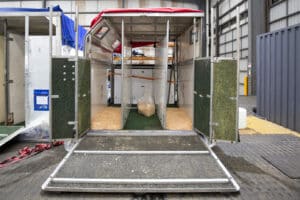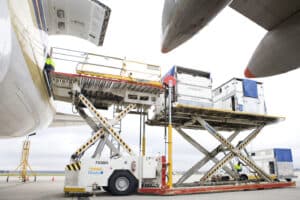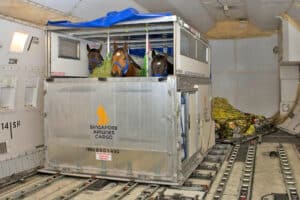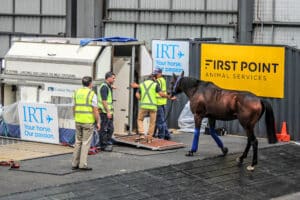There’s more to transporting horses internationally than you might think. REBECCA NADGE spoke to IRT’s Chris Burke to learn more.
While many owners may be well versed in transporting their horses by float or truck, the process of shipping horses internationally involves a very different set of requirements.
Chris Burke, Managing Director of IRT, tells me that a wide variety of horses travel globally: “In terms of the breeds we move around, it’s everything you can imagine. Mainly they’re Thoroughbreds, Standardbreds, Quarter Horses and performance horses, but it can also include Gypsy cobs, mini donkeys, mammoth donkeys – all sorts of different breeds. A fair few horses travel for racing or performance reasons, but probably the driving force behind the international movement of horses is breeding and bloodlines.”
Australia’s strict biosecurity laws mean that horses must complete 14 days quarantine at a government approved facility prior to leaving the country, and also immediately after arrival here.
Chris says the earlier owners get in touch about importing a horse, the smoother the process will be. If there isn’t an existing protocol within the country of origin, the risk of exotic disease may be too great and the horse may not meet entry requirements. “When they’re at the pre-purchase vetting stage, we give potential clients a list of exotic diseases to test that horse against, so they can avoid buying an animal that might never qualify to come to Australia,” he explains. “We suggest they tell the vendor they’ll buy the horses subject to those requirements. There’s nothing worse than someone ringing me to arrange importation of a horse, only for us to test it and discover there’s a problem. At that stage the vendors generally don’t want the horse back, and the buyer is stuck with a horse they can’t bring to Australia.”
IRT handles everything from collection to delivery, including agistment, quarantine, and flights, but the horse does need to have a clear form of identification. Microchips are required on all horses that travel around the world. “That microchip needs to be matched to some sort of breed registration, or perhaps an FEI passport, pet passport, breed passport, or something similar,” Chris tells me. “If the horse doesn’t have that, then we sometimes need a vet to microchip the horse so it can be identified. Then we can start the testing and vaccinations – but only once there’s a clear line of identification that the animal we are testing and treating is the animal we’re going to fly.”
When it comes to the actual flight, Chris recommends owners gradually adapt their feeding regime so the horse is carrying a bit of extra condition by the time they fly. Horses will typically lose between five and twenty-five kilograms on the flight, so a few extra kilograms can make a difference. He warns, however, that this needs to be planned well ahead of time. “Leading up to the flight we do ask that horses be weaned off the heavier grains. Your biggest risk really is colic during the flight, so you do try and wind down the feed as you get closer to the flight for that reason.” Hay is provided during the trip but hard feeds are avoided, although a couple of handfuls of feed may be offered on longer haul flights. Water intake is the bigger concern and molasses might be added to entice the horse to drink.

Air stable partitioning can be adjusted to accommodate from one to three horses
Horses travel in air stables on the main deck of a cargo aircraft, the same area in which passengers would sit during a regular commercial flight. Each stable can accommodate three standard sized horses. The horses are led into the stables at ground level, before being towed to the aircraft, loaded, and locked into position. Up to 87 horses can fit into the aircraft, although this will depend on how many horses are in each stable. “You can change the partitions in the stables, so there might only be two horses, or perhaps two heavy horses that need more room. Sometimes, for example, with the high value shuttle stallions, they might have the whole area to themselves. It’s kind of like first class, business class and economy,” Chris laughs.
It was once common for grooms to fly with the horses but increased security following September 11 has made it more difficult for people to travel on the same flight. The COVID pandemic added further complications, but Chris says in many cases it also comes down to the number of seats. “We make sure we have one of our professional grooms on the plane, and with some flights, especially some of the longer haul flights, we have a vet onboard too,” he explains.

Loading air stables onto the cargo aircraft’s main deck.
Another consideration is that a horse’s highest risk of travel sickness after a long journey is the first 48 hours after arrival. “Quite often when someone accompanies the horse all the way through on the flight, it’s fantastic that they’re there, but when they arrive they’re exhausted,” Chris explains, “and then they’re not around to keep an eye on the horse for the slightest change in their temperament, or their temperature, and that’s when they’re at the highest risk. We often encourage team riders to have their staff fly to the destination early and get a day or two’s sleep in the time zone of the new country, and then be there at the airport to take care of the horses from the minute they land. That’s really when they’re going to need you the most.”

Safely loaded with the air stable locked securely into place.
Unlike trucking or floating, in air stables horses are able to lower their heads and don’t need to brace during corners or when stopping at intersections. The takeoff and landing are the most disruptive and noisiest part of the journey, but changes in climate are another factor. “Every time you land at a different airport, it might be really cold, it might be high humidity. It’s a little bit different in terms of the extremes, but horses actually travel a lot better than you might think. We generally find that because they’re not moving around as much and we have the ability to get their heads down during the trip, they adapt to it.” However, transport companies are always looking for ways to take a shorter route, or to reduce the number of stopovers, as small improvements can make a big difference.

Rugs are not required for the temperature controlled flight.
Chris encourages owners to only travel their horses in gear that they’re accustomed to wearing. Rugs are not required as the temperature, which can get warm from the body heat of the horses, is controlled. He also recommends that shoes are removed, particularly the hinds, to reduce risk of injury. “Quite often owners might float their horse without anything on – but then they put the horse on a flight and want to dress it up with everything, thinking they’re protecting the animal. Sometimes all that extra gear causes the horse to fret and fidget as they try to work out what’s on their legs. As a consequence, they don’t settle and kick out the whole flight, which defeats what their owners were trying to achieve in the first place!”
For more information, call IRT on 03 9643 3030, or email irtaus@irt.com



